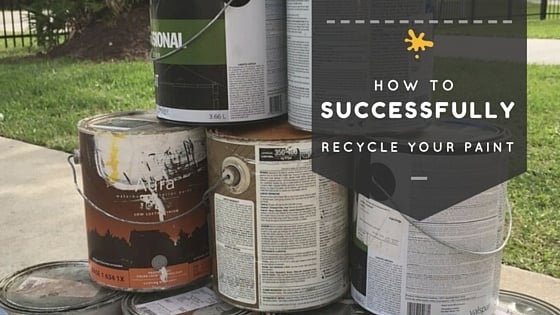According to a report published by the EPA, around 10 percent of the house paint purchased in the US each year becomes leftover. This amounts to more than 60 million gallons of paint waste annually. A small amount of this paint is kept to handle subsequent touch-up jobs. But that’s not enough. With no convenient options for recycling, most leftover paint ends up in the trash can, costing all of us a lot in terms of trash disposal fees, landfilling and environmental pollution.

As one of the few residential painting contractors preoccupied with public health and environmental protection, we’ve put together a succinct guide on how to recycle your paint and dispose of hazardous waste safely.
- Store unused paints – To successfully recycle your paint, you first need to store it properly for maximum shelf life. Residential painting contractors recommend covering the opening of the cans with plastic wrap prior to securing the lids. Then, label all the cans with the date, name of the paint and paint formula if it’s a computer-matched shade. To prevent the air from entering your cans, store them upside down in a cool, dry place.
- Return or reuse – Rather than letting leftover paint in your garage, or worse, disposing of it improperly, try to return unopened cans for an exchange or refund as soon as you complete your painting project. You can also use leftover paint as a base coat, mix it with other paints for functional paint jobs (e.g. painting your basement, garage, dog house, etc.), donate it for community painting projects or find a friend, relative or neighbor who could make good use of it.
- Recycle – Water-based acrylic latex paint isn’t considered hazardous. However, it can’t be placed in the garbage in its liquid state. For small amounts of paint, let the residue air dry. Once solidified, paint can be disposed of with regular trash. To recycle your paint cans and lids, check with your local recycling services if they accept empty metal paint cans. If you have large quantities of leftover and unusable water-based paint, ask the local waste disposal service provider if there are any programs for repurposing paint into new products, such as additives for concrete. If no such programs are available, pour the paint on plastic sheets, let it dry and throw it away.
- Dispose – Oil-, solvent-based paints and paint thinners should be disposed of as hazardous household waste (HHW). To safely get rid of old oil- or solvent-based paint you no longer need, brush it on to scrap paper or cardboard and allow it to dry in a well-ventilated area. If you have large amounts of paint, pour a one-inch-deep layer into one or more cardboard boxes lined with plastic; let the paint harden and pour another layer. To speed up the hardening process, you can use paint hardener or mix the paint with sand or sawdust. Then, contact a local hazardous waste collection center to arrange for a drop-off or pick-up of the waste matter. To dispose of small amounts of paint thinner, we recommend letting the product evaporate outside.
In Florida, household hazardous waste collection centers have implemented programs to help homeowners and businesses recycle or properly dispose of their non-hazardous and hazardous wastes. If you live in Jacksonville, Tampa, FL, or within adjoining areas, and wish to recycle your paint, please visit your local Household Hazardous Waste website for more information on how you can do this.
On the other hand, if you’re looking for full-service interior and exterior residential painting contractors, contact our team of experts today. Besides delivering quality finishes that last, our Florida residential painters will take care of job cleanup and hazardous waste disposal. This means that you don’t need to worry about dealing with unused paint and other residues that are part of any paint job.






